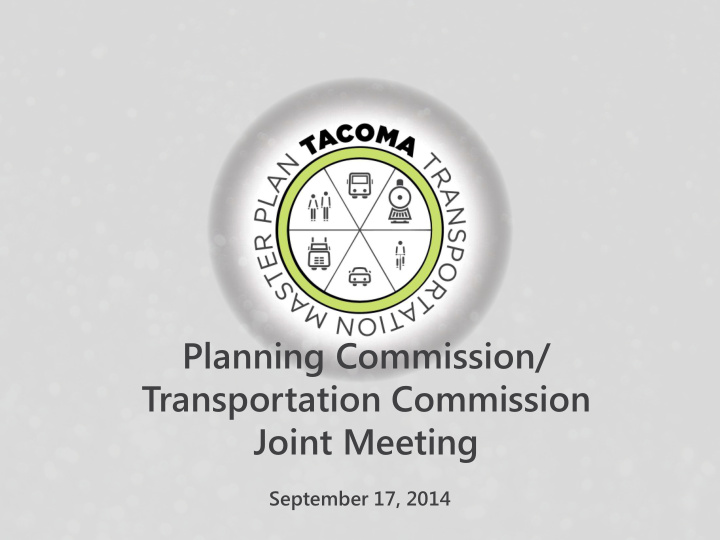



Planning Commission/ Transportation Commission Joint Meeting September 17, 2014
GMA REQUIREMENTS FOR TRANSPORTATION Land use assumptions align with travel demand forecasts Intergovernmental coordination Facility recommendations align with level of service objectives Financially constrained September 15, 2014
PLANNING FOR EVERYONE Balance and prioritize design to meet street’s purpose September 15, 2014
COMPLETE STREETS/NETWORKS Modal priority networks establish where modes need to be best accommodated Develop LOS policies for following modes: Pedestrian » Bike » Transit » Auto/Freight » September 15, 2014 4
KEY PRINCIPLE: NOT JUST CURB-TO-CURB Use all of the public right-of-way To relate to private development September 15, 2014
KEY PRINCIPLE: CONTEXT SENSITIVE CONTEXT FACTORS CONVENTIONAL Land Use Type » Development Densities » Form (e.g. height & » setback) Corridor Users » September 15, 2014
BUILDING REALISTIC EXPECTATIONS September 15, 2014
TMP SCOPE OF WORK Public Engagement Existing Conditions Goals and Policies Priorities Focus Areas: Modes Land Use » Roadways » Transit » Funding Bike/Pedestrian » Port Access » Performance Measures Cost Estimation Financial Plan GMA/Concurrency TMP Plan Development 8 September 15, 2014
ARE WE THERE YET? September 15, 2014
TWO STAGE PROCESS Initial Input: Land use and policies » Bike/ped modes » (BPTAG) Transit » Auto/freight » More Refined Input Land use and policies » (tonight) Bike/ped modes » (August) Transit (August) » Auto/freight (tonight) » September 15, 2014
BRINGING IT ALL TOGETHER Consider modes together Understand key corridors » with priority conflicts Understand funding availability Understand City’s land use vision Develop LOS standards and project list that aligns with all of the above September 15, 2014
BRINGING IT ALL TOGETHER September 15, 2014 12
Questions? Dan Grayuski d.grayuski@fehrandpeers.com Kendra Breiland k.breiland@fehrandpeers.com September 15, 2014
20-M INUTE N EIGHBORHOODS Planning Commission / Transportation Commission Joint Meeting Jane Moore, Tacoma Transportation Commission Justin Resnick, Fehr & Peers SEPTEMBER 17, 2014
PLANNING FOR PEDESTRIANS Where do people want to walk? Markets Parks School September 16, 2014
TIES TO GROWTH PSRC growth targets allocated to mixed-use centers Subarea Plans depend heavily on non-SOV travel Activity centers tend to be oriented toward walking already September 16, 2014
EFFORTS IN MOMAP Policy Language: Prioritize infrastructure improvements within and between 20-minute neighborhoods based around Tacoma’s centers for growth and along identified corridors that connect residential areas to schools, local retail, business, and community services so residents can safely access more of the services they need close to home by walking, biking, transit, and using assistive devices. September 16, 2014
20-MINUTE NEIGHBORHOODS The Three D’s Density - Population density by housing units per acre Distance - Intersection density - Topography - Distance to transit Destinations - Major employers, schools, parks, libraries, grocery stores September 16, 2014
EXISTING 20-MINUTE NEIGHBORHOOD POTENTIAL September 16, 2014
FUTURE 20-MINUTE NEIGHBORHOOD POTENTIAL September 16, 2014
20-MINUTE WALKS AND GROWTH 3 Ds Analysis Equally Weighted - Focus on MUCs since they are the targeted growth areas - Most MUCs are located at or near a potential 20-minute neighborhood - What about the MUCs that have less walking potential? Lower priority for projects Walking Around Mixed Use Centers - Half mile (10 minutes) and one mile (20 minutes) walking from centroids - Note street network completeness - Sidewalk data unavailable September 16, 2014
CONNECTING 20-MINUTE NEIGHBORHOODS Connecting Transit Service - Nearly all MUCs connected by proposed High Capacity Transit Corridors - Excludes local service currently - Think about higher quality of transit service along these corridors Connecting Bicycle Facilities - Some MUCs connected by existing bicycle facilities - All MUCs connected by fully built out bicycle network - Consider separated bicycle facilities for important 20-min NBH connections September 16, 2014
ARTERIALS AND COLLECTORS IN 20-MINUTE NEIGHBORHOODS September 16, 2014
ARTERIALS AND COLLECTORS IN 20-MINUTE NEIGHBORHOODS September 16, 2014
ARTERIALS AND COLLECTORS IN 20-MINUTE NEIGHBORHOODS September 16, 2014
ARTERIALS AND COLLECTORS IN 20-MINUTE NEIGHBORHOODS September 16, 2014
Questions? Justin Resnick j.resnick@fehrandpeers.com Mike Tresidder miket@altaplanning.com September 16, 2014
Recommend
More recommend